Apple iPad mini with Retina Display: Reviewed
by Anand Lal Shimpi on November 16, 2013 8:00 AM ESTThe Display
The big story behind the new iPad mini is of course its 7.85-inch Retina Display. We’re talking about the same 2048 x 1536 resolution as the iPad Air, but in a much smaller form factor. The result is the highest pixel density of any Apple display ships today, tying with the iPhone 5S. The impact on the overall experience is pretty significant. Text is obviously a lot sharper, but even graphics are a lot nicer to look at on the new Retina Display. The gains aren't quite as obvious as they were on the larger iPad, but after living with the Retina mini for a while I can't easily go back to the previous version.

iPad mini (left) vs. iPad mini with Retina Display (right)
I ran Marco Arment's image retention test on the Retina mini and didn't see even the slightest degree of image retention. My old, non-Retina iPad mini on the other hand exhibited image retention. I suspect Apple is multi-sourcing its displays here, which could obviously contribute to varied behavior. At least on the two minis I have, image retention isn't an issue.
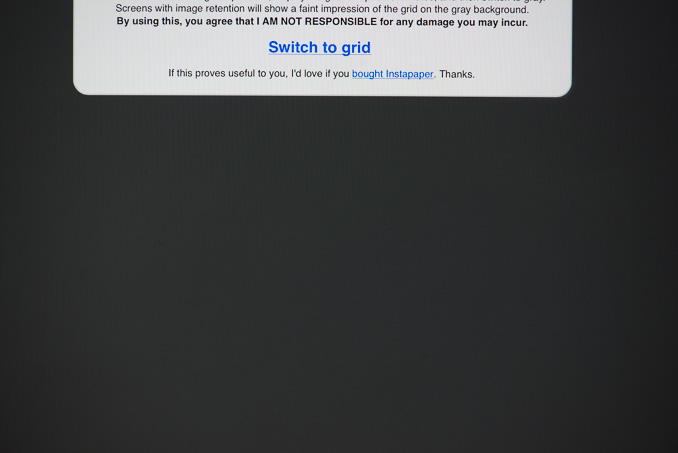
In the conclusion of my iPad Air review I wrote about the new mini as finally being a no-compromises smaller iPad. Much like my assertions last year of a Retina mini not being in the cards, it turns out that I was wrong on this point as well. Although display resolution is no longer a concern on the mini, color gamut hasn’t changed between the old and new minis. A quick look at our gamut test gives us an idea of what’s going on:

The iPad mini with Retina Display has the same color gamut as the standard iPad mini, which is narrower than the iPad Air and less than the sRGB coverage we normally look for. The biggest issue here is that there are other smaller tablets in this price range that do offer sRGB coverage (e.g. Nexus 7, Kindle Fire HDX 8.9).
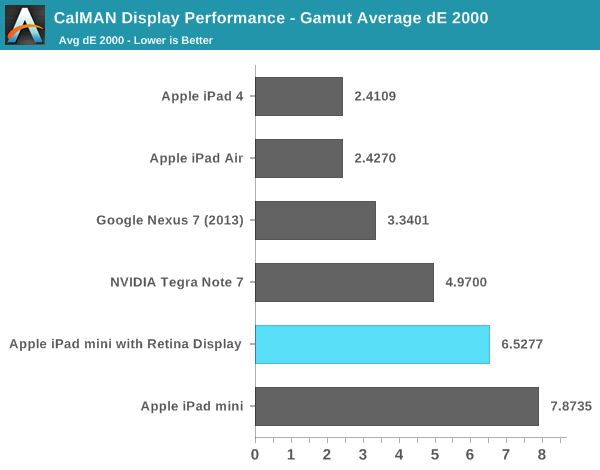
I suspect the justification here is Apple likely views the bigger iPad as being a better fit for photographers/those who care about color reproduction, but it’s a shame that this is a tradeoff that exists between the two iPads especially given how good Apple is about sRGB coverage in nearly all of its other displays.
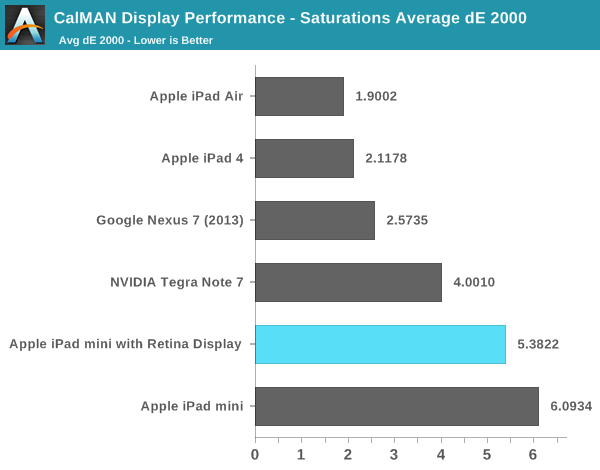

One of the simplest visual tests is to use one of iOS 7’s more colorful wallpapers and compare the Retina mini and iPad Air side by side:
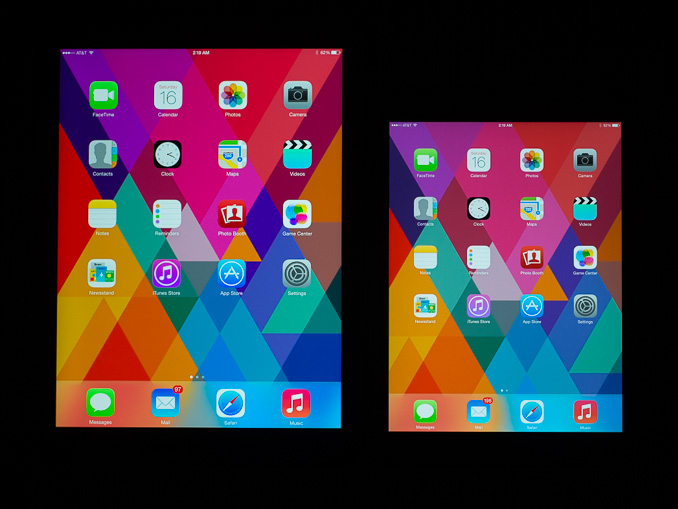
Pay attention to the color of the red triangles in the lower left
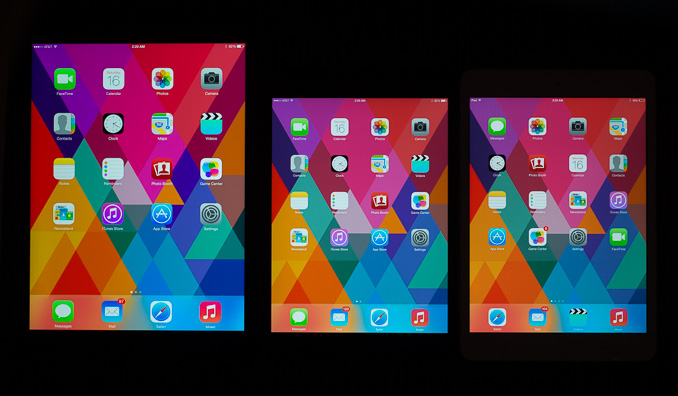
From left to right: iPad Air, iPad mini with Retina Display, iPad mini
The difference is small but apparent, particularly if you’re used to panels with full sRGB coverage like the iPad Air or any of the rMBPs/iMacs. The biggest deviations are in reds/blues and magenta in between as you can tell from the CIE chart above.

Within its gamut coverage, the mini’s panel is fairly accurate. A look at our GMB checker test shows performance competitive with the Nexus 7 and not far off the 4th generation iPad. Grayscale reproduction is also quite good. The display looks really good otherwise, but you don’t get the same visual punch you do on the iPad Air.
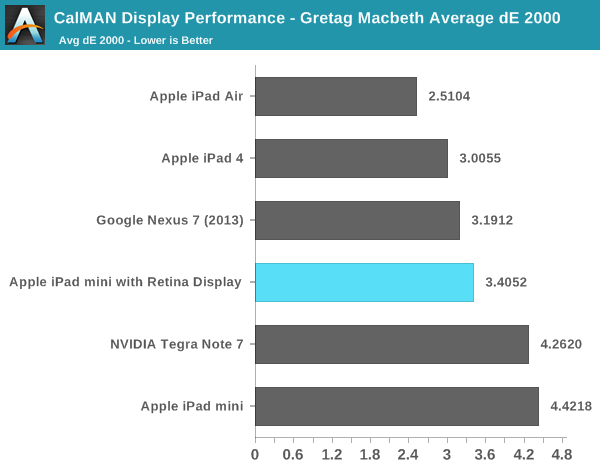

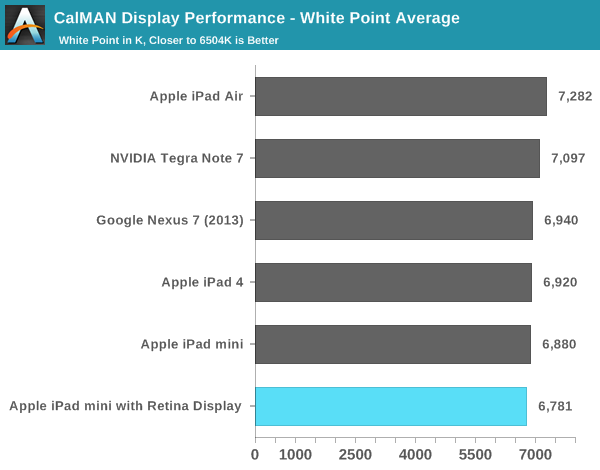
Compared to the previous generation mini we’re obviously talking about a much better panel. But for those of you on the fence between the mini and Air, the Air does still hold a display advantage.
Black levels are competitive and contrast ratio stays fixed at around 800:1 regardless of whether we’re talking about max brightness or the 200 nits we run all of our battery life tests at. Max brightness is down a bit compared to the iPad Air.
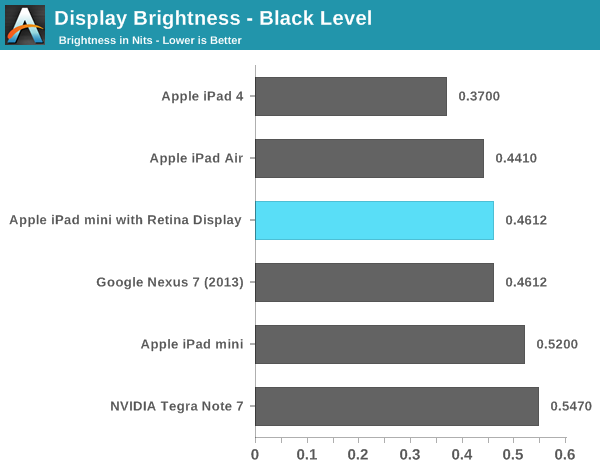
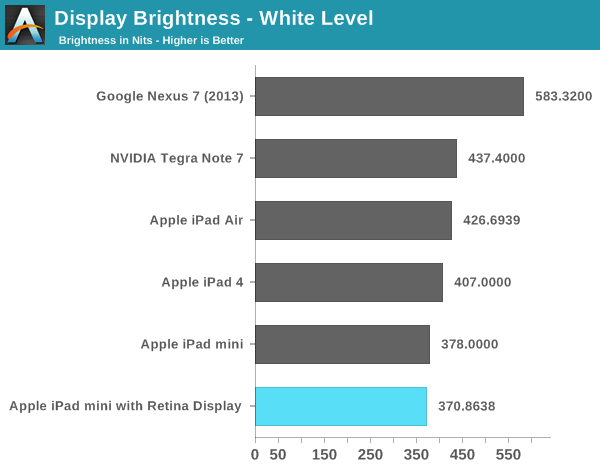
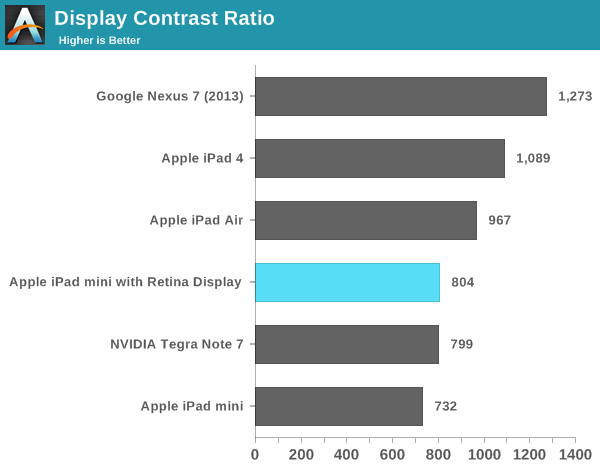










345 Comments
View All Comments
MarcSP - Sunday, November 17, 2013 - link
Surface is not x86. I don't understand why the CPU architecture is important for the common user. I think the overall experience is what they mind. And, anyway, latest x86 SoC are as good or better than ARM counterparts in performance and power consumption.zeagus - Monday, November 18, 2013 - link
Competitive, not as good or better. The A7 and even IIRC SnapDragon 8xx beats the latest x86 mobile SoC from Intel.MarcSP - Monday, November 18, 2013 - link
Ok, but my point is still valid, that x86 or ARM is barely something relevant when choosing one device (being other factors, such as the OS, the same or similar).ananduser - Sunday, November 17, 2013 - link
The Verge also noticed performance issues, stuttering and lag.socio-statistical - Monday, November 18, 2013 - link
Good luck getting an Android user to admit even that their device is an outright copy of the iPad (which literally everyone else can see) let alone that anyone would consider buying the iPad it so obviously copies. At least MSFT finally produced a not-totally-cribbed from Apple device. (If we can at this point consider Windows to be anything remotely 'new' or original that is.)MrX8503 - Saturday, November 16, 2013 - link
Srry KPOM. Meant to reply to BPB.BPB - Saturday, November 16, 2013 - link
The day this site recommends an Android or Windows device over the competing Apple product I will reconsider. My point is that in the end every article/review here leans Apple when Apple is involved. Heck, the phone guy doesn't even do Windows Phone devices and openly mocks them. At the end of the day they will give the Apple competitors some praise, but they don't recommend the competitors over Apple.Check out the Nexus 7 conclusion:
"The original Nexus 7 gave us a decent Android experience at a very low cost. This year ASUS and Google raised the bar for sure. The new Nexus 7 is no longer just a decent tablet at a good price, it's an incredible tablet. With this Nexus, it's clear that Google no longer wants to rely on value alone. The 2013 Nexus 7 redefines what you should expect to pay for a truly great tablet. If you're in the market for an ultra portable tablet, and definitely if you're shopping for an Android tablet in particular, the new Nexus 7 should be at the top of your list. It's so good that I'm giving it our Silver Award."
An "incredible" and "truly great" tablet at a good price gets a silver award, not gold. What does it take to get gold? Possibly, just possibly, a company name that is a fruit.
chaosbloodterfly - Saturday, November 16, 2013 - link
The only gold award given to a smartphone was to the HTC One, a decidedly not fruity company. Anandtech also doesn't give out awards lightly. There isn't even an award in this review. Or the 5s review. Stop grasping at straws here.KPOM - Saturday, November 16, 2013 - link
I don't believe Anand has ever actually awarded an Apple product a gold award (at least not recently).BPB - Saturday, November 16, 2013 - link
By the way, I in no way deny the fact that Apple makes good stuff. My best friend and my brother use their products, and they are not fools.I didn't realize I accidently deleted the following from my previous comment:
"Yes, Apple doesn't get an award here, nor do I see any in other reviews I found after a quick search. But I think I know why that is. In order to give out awards you need to have competition, here, at least, Apple has none."